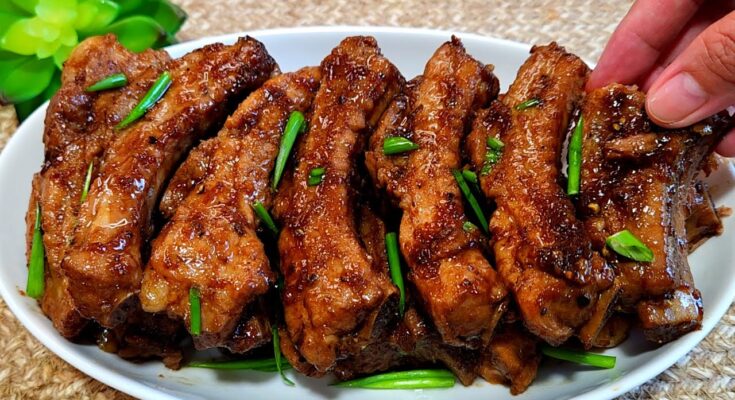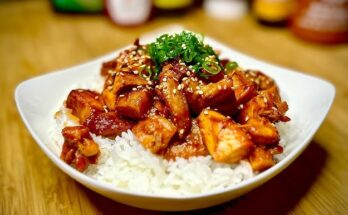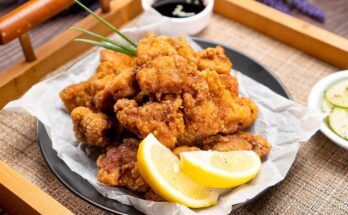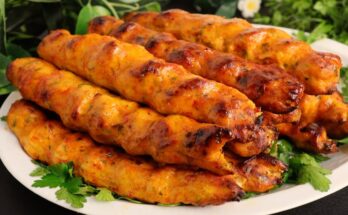Pork Ribs Recipe: Pork ribs are a crowd-pleaser, loved for their tender, flavorful meat that falls right off the bone. Whether you’re preparing them for a family barbecue, a summer cookout, or a cozy dinner, mastering the art of cooking pork ribs is worth the effort.
In this guide, I’ll walk you through everything from choosing the right ribs to serving them up like a pro. Ready? Let’s get started!
Types of Pork Ribs
Baby Back Ribs
Baby back ribs are the smallest and most tender type of ribs. They come from the upper portion of the pig’s rib cage and are curved, with leaner meat compared to other types. These ribs cook faster, making them a great choice for beginners or when you’re short on time. Baby back ribs are perfect for grilling or baking.
Spare Ribs
Spare ribs are larger, meatier, and slightly fattier than baby back ribs. They come from the lower part of the ribcage, near the belly. The extra fat enhances their flavor, making them ideal for low-and-slow cooking methods like smoking or baking.
St. Louis-Style Ribs
These are spare ribs trimmed into a rectangular shape, removing excess cartilage and fat. They’re a favorite for competitions because of their uniform appearance and rich, porky flavor. St. Louis-style ribs are great for both grilling and smoking.
Essential Ingredients
To make delicious pork ribs, you’ll need the following:
- Ribs: Choose between baby back, spare, or St. Louis-style ribs.
- Dry Rub: Paprika, brown sugar, garlic powder, onion powder, salt, and pepper.
- Sauce: Barbecue sauce of your choice (sweet, tangy, or smoky).
- Other Ingredients: Olive oil, apple cider vinegar, honey, or mustard (optional for marinades).
For substitutions, try honey instead of brown sugar or coconut aminos for soy sauce if you’re keeping it healthy.
Tools and Equipment
Grill vs. Oven vs. Smoker
- Grill: Perfect for a smoky char and quick cooking.
- Oven: Convenient for consistent temperature control and tender results.
- Smoker: Ideal for flavor-packed, fall-off-the-bone ribs.
You’ll also need tongs, aluminum foil, a meat thermometer, a basting brush, and a sharp knife for slicing.
Preparing the Ribs
Removing the Membrane
The membrane on the back of the ribs can make them tough and chewy. Use a knife to loosen one corner, then grip it with a paper towel and pull it off in one piece. It’s a game-changer for tenderness.
Applying a Dry Rub or Marinade
Generously season your ribs with your dry rub, making sure to massage it into every crevice. For marinades, let the ribs soak for at least 4 hours or overnight for maximum flavor.
Letting the Ribs Rest
Before cooking, allow the ribs to sit at room temperature for about 30 minutes. This helps them cook more evenly.
Cooking Techniques
Low and Slow Cooking
Low and slow is the secret to tender, juicy pork ribs. Cook at 225–250°F for several hours, whether in the oven, on a grill, or in a smoker.
Grilling the Ribs
Set up your grill for indirect heat. Sear the ribs for 5–10 minutes on each side, then move them to indirect heat, cover, and cook until tender.
Smoking the Ribs
If you’re smoking, aim for a temperature of 225°F and use wood chips like hickory or applewood for flavor. Smoke for 4–6 hours, depending on the rib type.
Oven-Baked Pork Ribs
Preheating and Baking Instructions
Preheat your oven to 300°F. Place the seasoned ribs on a baking sheet lined with foil, bone-side down.
Wrapping the Ribs in Foil
After an hour of cooking, wrap the ribs in foil with a splash of apple cider vinegar or water to retain moisture. Bake for another 1–2 hours.
Broiling for a Crispy Finish
Remove the foil, slather the ribs in barbecue sauce, and broil for 5–10 minutes for a caramelized crust.
Grilled Pork Ribs
Prepping the Grill
Clean and oil your grill grates. Set up for indirect heat by placing charcoal or burners on one side only.
Monitoring the Cooking Process
Flip the ribs occasionally and baste them with barbecue sauce during the last 30 minutes to avoid burning the sugars.
Adding Sauce While Grilling
Wait until the ribs are almost done before adding sauce. This prevents it from burning but still gives you that sticky, flavorful coating.
Smoked Pork Ribs
Choosing the Right Wood
The type of wood you use for smoking plays a huge role in the flavor of your pork ribs. Some popular options include:
- Hickory: Adds a strong, smoky flavor, perfect for traditional BBQ.
- Applewood: Delivers a sweeter, fruitier smoke.
- Mesquite: Provides a bold, earthy flavor but should be used sparingly as it can overpower the meat.
You can also mix woods, like combining applewood and hickory, to balance sweetness and smokiness.
Smoking the Ribs
Start by preheating your smoker to 225°F. Place the ribs on the smoker, bone-side down, and let them cook slowly. Check the smoker every hour to ensure the temperature stays consistent. If you’re using a water pan in your smoker, refill it as needed to keep the environment moist.
Maintaining Heat and Moisture
Wrap the ribs in foil after 3 hours of smoking to prevent them from drying out. Add a splash of apple juice or cider vinegar before sealing the foil for added moisture. Smoke for another 2–3 hours until the meat is tender and easily pulls away from the bone.
Final Touches
Resting the Ribs
Once the ribs are cooked to perfection, resist the urge to slice them immediately. Let the ribs rest for about 10–15 minutes to allow the juices to redistribute. This step ensures every bite is juicy and flavorful.
Slicing the Ribs
To slice your ribs, place them meat-side down on a cutting board. Use a sharp knife to cut between the bones for even portions. Serve with extra barbecue sauce on the side for dipping.
Serving Suggestions
Pair your pork ribs with classic barbecue sides to round out the meal. Some popular options include:
- Coleslaw: The crunch and tanginess cut through the richness of the ribs.
- Baked Beans: Smoky, sweet, and hearty.
- Cornbread: A soft, buttery complement to the smoky ribs.
- Grilled Vegetables: For a lighter, healthier side.
For drinks, consider iced tea, lemonade, or a crisp beer to complete the barbecue experience.
Tips for Perfect Pork Ribs
Want your ribs to turn out flawless every time? Keep these tips in mind:
- Low and Slow is Key: Rushing the cooking process will result in tough, dry ribs.
- Don’t Skip the Resting: Resting the ribs after cooking locks in moisture.
- Choose the Right Sauce: Balance the sweetness, tanginess, and spice to match your taste.
- Don’t Overdo the Sauce: Let the flavor of the meat and rub shine through, and use the sauce sparingly.
- Use a Meat Thermometer: Cook until the internal temperature reaches about 190–203°F for tender, fall-off-the-bone results.
Storing and Reheating
Proper Storage Techniques
If you have leftovers (lucky you!), wrap the ribs tightly in aluminum foil or store them in an airtight container. Refrigerate for up to 4 days or freeze for up to 3 months.
How to Reheat Ribs Without Drying Them Out
To reheat, wrap the ribs in foil and place them in a 250°F oven for about 20–30 minutes. Add a splash of water or apple juice inside the foil to keep them moist. For a crispy finish, broil for a few minutes after reheating.
FAQs about Pork Ribs Recipe
1. What is the best temperature to cook pork ribs?
For juicy and tender pork ribs, it’s ideal to cook them at a low temperature, typically around 225°F to 250°F (107°C to 121°C). This slow-cooking process allows the fat and connective tissue in the ribs to break down gradually, resulting in perfectly tender meat.
2. How long should pork ribs cook?
The cooking time for pork ribs depends on the method and temperature used. Generally, ribs cooked in a smoker or oven at 225°F can take about 4 to 5 hours. If you’re grilling, the ribs might take closer to 1.5 to 2.5 hours over indirect heat.
3. Should I wrap my pork ribs in foil?
Wrapping pork ribs in foil, also known as the “Texas crutch,” can speed up the cooking process and help the ribs retain moisture. It’s recommended to wrap the ribs after the first 2 or 3 hours of cooking, then unwrap for the final hour to allow the exterior to crisp up.
4. What are the best seasonings for pork ribs?
A simple dry rub for pork ribs might include ingredients like brown sugar, paprika, garlic powder, salt, and pepper. For a bolder flavor, you can experiment with cayenne pepper, cumin, and smoked paprika. Many also enjoy brushing their ribs with a barbecue sauce during the last 30 minutes of cooking for added flavor and glaze.
5. How can I tell when pork ribs are done cooking?
Pork ribs are done when their internal temperature reaches 145°F (63°C), but for the best texture and tenderness, many chefs recommend cooking them until they reach an internal temperature of around 195°F to 203°F (90°C to 95°C). Another indicator is when the meat shrinks back from the bones about 1 inch and the ribs bend easily when lifted.
Conclusion
Cooking pork ribs might seem intimidating at first, but with this step-by-step guide, you’ll be serving up tender, juicy, and flavorful ribs in no time. Whether you prefer baking, grilling, or smoking, this recipe is versatile and easy to follow. Pair your ribs with classic sides, and you’ll have a meal that’ll leave everyone asking for seconds. So fire up the grill (or oven), grab your favorite barbecue sauce, and get ready to impress!



